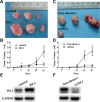ISL1, a novel regulator of CCNB1, CCNB2 and c-MYC genes, promotes gastric cancer cell proliferation and tumor growth
- PMID: 27183908
- PMCID: PMC5095015
- DOI: 10.18632/oncotarget.9269
ISL1, a novel regulator of CCNB1, CCNB2 and c-MYC genes, promotes gastric cancer cell proliferation and tumor growth
Abstract
Islet-1 (ISL1) belongs to the LIM homeodomain transcription factor family, which is specifically expressed in certain tissue types only. Previously, we reported that ISL1 is aberrantly overexpressed in gastric cancer (GC). However, its role in GC is not clear. Here, we report that ISL1 is aberrantly upregulated not only in human gastric carcinoma tissues but also in some GC cell lines. Upregulated ISL1 expression enhanced xenografted gastric carcinoma development, while ISL1 knockdown inhibited GC growth in nude mice. ISL1 overexpression promoted GC cell proliferation, colony formation, and cell growth in soft agar, and facilitated cell cycle transition in GC cells, demonstrated an increase in the proportion of cells in the G2/M and S phases and a decrease in the proportion of cells in the G1 phase. Furthermore, we provide evidence that ISL1 is a novel regulator of the cyclin B1 (CCNB1), cyclin B2 (CCNB2) and c-myc (c-MYC) genes. ISL1 activated the expression of these genes in GC cells by binding to the conserved binding sites on their promoters or enhancers. The expression levels of the genes were decreased in response to ISL1 knockdown. Therefore, ISL1 may serve as a potential therapeutic target in GC.
Keywords: CCNB; ISL1; c-MYC; gastric cancer; proliferation.
Conflict of interest statement
The authors declare that no conflicts of interest exist.
Figures






Similar articles
-
Phosphorylation of islet-1 serine 269 by CDK1 increases its transcriptional activity and promotes cell proliferation in gastric cancer.Mol Med. 2021 May 7;27(1):47. doi: 10.1186/s10020-021-00302-6. Mol Med. 2021. PMID: 33962568 Free PMC article.
-
LMX1A inhibits C-Myc expression through ANGPTL4 to exert tumor suppressive role in gastric cancer.PLoS One. 2019 Sep 26;14(9):e0221640. doi: 10.1371/journal.pone.0221640. eCollection 2019. PLoS One. 2019. PMID: 31557193 Free PMC article.
-
MiRNA29a-3p negatively regulates ISL1-Integrin β1 axis to suppress gastric cancer progression.Exp Cell Res. 2024 Nov 1;443(1):114288. doi: 10.1016/j.yexcr.2024.114288. Epub 2024 Oct 26. Exp Cell Res. 2024. PMID: 39490753
-
The Complex Network between MYC Oncogene and microRNAs in Gastric Cancer: An Overview.Int J Mol Sci. 2020 Mar 5;21(5):1782. doi: 10.3390/ijms21051782. Int J Mol Sci. 2020. PMID: 32150871 Free PMC article. Review.
-
MYC in Brain Development and Cancer.Int J Mol Sci. 2020 Oct 20;21(20):7742. doi: 10.3390/ijms21207742. Int J Mol Sci. 2020. PMID: 33092025 Free PMC article. Review.
Cited by
-
Identification of early diagnostic biomarkers for breast cancer through bioinformatics analysis.Medicine (Baltimore). 2023 Sep 15;102(37):e35273. doi: 10.1097/MD.0000000000035273. Medicine (Baltimore). 2023. PMID: 37713876 Free PMC article.
-
Integrative module analysis of HCC gene expression landscapes.Exp Ther Med. 2020 Mar;19(3):1779-1788. doi: 10.3892/etm.2020.8437. Epub 2020 Jan 8. Exp Ther Med. 2020. PMID: 32104233 Free PMC article.
-
Bioinformatics-Driven Investigations of Signature Biomarkers for Triple-Negative Breast Cancer.Bioinform Biol Insights. 2025 Mar 2;19:11779322241271565. doi: 10.1177/11779322241271565. eCollection 2025. Bioinform Biol Insights. 2025. PMID: 40034579 Free PMC article.
-
Prognostic Genes of Breast Cancer Identified by Gene Co-expression Network Analysis.Front Oncol. 2018 Sep 11;8:374. doi: 10.3389/fonc.2018.00374. eCollection 2018. Front Oncol. 2018. PMID: 30254986 Free PMC article.
-
Cyclin B2 overexpression promotes tumour growth by regulating jagged 1 in hepatocellular carcinoma.Aging (Albany NY). 2022 Mar 29;14(6):2855-2867. doi: 10.18632/aging.203979. Epub 2022 Mar 29. Aging (Albany NY). 2022. PMID: 35349480 Free PMC article.
References
-
- Torre LA, Bray F, Siegel RL, Ferlay J, Lortet-Tieulent J, Jemal A. Global cancer statistics, 2012. CA Cancer J Clin. 2015;65:87–108. - PubMed
-
- Karlsson O, Thor S, Norberg T, Ohlsson H, Edlund T. Insulin gene enhancer binding protein Isl-1 is a member of a novel class of proteins containing both a homeo- and a Cys-His domain. Nature. 1990;344:879–882. - PubMed
-
- Hobert O, Westphal H. Functions of LIM-homeobox genes. Trends Genet. 2000;16:75–83. - PubMed
-
- Dong J, Asa SL, Drucker DJ. Islet cell and extrapancreatic expression of the LIM domain homeobox gene isl-1. Mol Endocrinol. 1991;5:1633–1641. - PubMed
MeSH terms
Substances
LinkOut - more resources
Full Text Sources
Other Literature Sources
Medical
Miscellaneous

